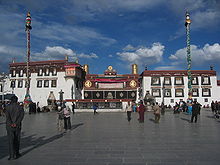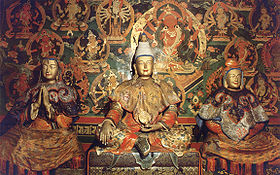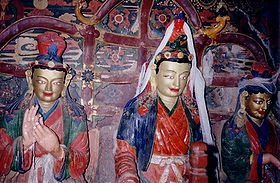
Princess Wencheng
Encyclopedia
Princess Wencheng (died 680) was a niece of the powerful Emperor Taizong
of China's Tang Dynasty
, who left China in 640, according to records, arriving the next year in Tibet
to marry the thirty-seven year old Songtsän Gampo (605?–650 CE) the thirty-third king of the Yarlung Dynasty of Tibet
, in a marriage of state
as part of a peace treaty
along with large quantities of gold. She is popularly known in Tibet as Gyasa, or 'Chinese wife'. The princess is portrayed as a Buddhist
and, along with Songtsän Gampo's Nepalese wife, Bhrikuti Devi, is said to have introduced Buddhism to Tibet.
The Chinese records mention receiving an envoy in 634 from Songtsän Gampo wherein the king requested (Tibetan sources say demanded) to marry a Chinese princess and was refused. In 635/636 the Tibetan king's forces attacked and defeated the 'A zha people , who lived around Lake Koko Nor in present-day Qinghai
, along an important trade route
into China. After a campaign against China in 635–6
(OTA l. 607) (during which Chinese won) the Chinese emperor agreed (under threat of force, according to Tibetan histories) to marry a Chinese princess to king Songtsän Gampo as part of the diplomatic settlement. As a marriage of state, the union must be considered a success as peace between China and Tibet prevailed for the remainder of Songtsen Gampo's reign.

and Chinese princess Wencheng brought Buddhism to Tibet, and further, that their complicated relationship as co-wives led to the construction of the Jokang Temple, whereupon the city of Lhasa. These stories are included in such medieval romances as the Mani-bka'-'bum, and historiographies such as the Rgyal-rabs Gsal-ba'i Me-long.
Chinese sources credit Wencheng with bringing Chinese culture to Tibet, but this is not corroborated by Tibetan sources.
Changzhug
monastery in Nêdong
is also connected with Wencheng: a tangka embroidered by Wencheng is kept in one of its chapels.


Emperor Taizong of Tang
Emperor Taizong of Tang , personal name Lǐ Shìmín , was the second emperor of the Tang Dynasty of China, ruling from 626 to 649...
of China's Tang Dynasty
Tang Dynasty
The Tang Dynasty was an imperial dynasty of China preceded by the Sui Dynasty and followed by the Five Dynasties and Ten Kingdoms Period. It was founded by the Li family, who seized power during the decline and collapse of the Sui Empire...
, who left China in 640, according to records, arriving the next year in Tibet
Tibet
Tibet is a plateau region in Asia, north-east of the Himalayas. It is the traditional homeland of the Tibetan people as well as some other ethnic groups such as Monpas, Qiang, and Lhobas, and is now also inhabited by considerable numbers of Han and Hui people...
to marry the thirty-seven year old Songtsän Gampo (605?–650 CE) the thirty-third king of the Yarlung Dynasty of Tibet
Tibet
Tibet is a plateau region in Asia, north-east of the Himalayas. It is the traditional homeland of the Tibetan people as well as some other ethnic groups such as Monpas, Qiang, and Lhobas, and is now also inhabited by considerable numbers of Han and Hui people...
, in a marriage of state
Marriage of state
A marriage of state in ancient use is a diplomatic marriage or union between two members of different nation-states or internally, between two power blocks, usually in authoritarian societies and is a practice which dates back into pre-history, as far back as early Grecian cultures in western...
as part of a peace treaty
Peace treaty
A peace treaty is an agreement between two or more hostile parties, usually countries or governments, that formally ends a state of war between the parties...
along with large quantities of gold. She is popularly known in Tibet as Gyasa, or 'Chinese wife'. The princess is portrayed as a Buddhist
Buddhism
Buddhism is a religion and philosophy encompassing a variety of traditions, beliefs and practices, largely based on teachings attributed to Siddhartha Gautama, commonly known as the Buddha . The Buddha lived and taught in the northeastern Indian subcontinent some time between the 6th and 4th...
and, along with Songtsän Gampo's Nepalese wife, Bhrikuti Devi, is said to have introduced Buddhism to Tibet.
The Chinese records mention receiving an envoy in 634 from Songtsän Gampo wherein the king requested (Tibetan sources say demanded) to marry a Chinese princess and was refused. In 635/636 the Tibetan king's forces attacked and defeated the 'A zha people , who lived around Lake Koko Nor in present-day Qinghai
Qinghai
Qinghai ; Oirat Mongolian: ; ; Salar:) is a province of the People's Republic of China, named after Qinghai Lake...
, along an important trade route
Trade route
A trade route is a logistical network identified as a series of pathways and stoppages used for the commercial transport of cargo. Allowing goods to reach distant markets, a single trade route contains long distance arteries which may further be connected to several smaller networks of commercial...
into China. After a campaign against China in 635–6
Emperor Taizong's campaign against Tufan
Emperor Taizong of Tang , the second emperor of Chinese dynasty Tang Dynasty, subjugated the Xianbei state Tuyuhun in 635. Thereafter, Tuyuhun's southwestern neighbor, the Tibetan state Tufan, rose in power and soon displaced Tuyuhun as the major threat to Tang's west...
(OTA l. 607) (during which Chinese won) the Chinese emperor agreed (under threat of force, according to Tibetan histories) to marry a Chinese princess to king Songtsän Gampo as part of the diplomatic settlement. As a marriage of state, the union must be considered a success as peace between China and Tibet prevailed for the remainder of Songtsen Gampo's reign.

The wedding's cultural importance
Myths about Songtsän Gampo and his Chinese bride Wencheng that appeared during the Middle Ages transformed Songtsän Gampo into a cultural hero for Tibetans, based on his marriages http://www.travelchinaguide.com/attraction/tibet/lhasa/jokhang.htm. It is widely believed that his state marriages to Nepalese princess BhrikutiBhrikuti
The Nepali Princess Bhrikuti Devi, known to Tibetans as Bal-mo-bza' Khri-btsun, Bhelsa Tritsun or, simply, Khri bTsun , is traditionally considered to have been the first wife of the earliest emperor of Tibet, Songtsän Gampo , and an incarnation of Tara...
and Chinese princess Wencheng brought Buddhism to Tibet, and further, that their complicated relationship as co-wives led to the construction of the Jokang Temple, whereupon the city of Lhasa. These stories are included in such medieval romances as the Mani-bka'-'bum, and historiographies such as the Rgyal-rabs Gsal-ba'i Me-long.
Chinese sources credit Wencheng with bringing Chinese culture to Tibet, but this is not corroborated by Tibetan sources.
Changzhug
Changzhug
Tradruk Temple, also written Changzhug Monastery , in the Yarlung Valley is the earliest great geomantic temple after the Jokhang - and some sources say it is even pre-dates the Jokhang....
monastery in Nêdong
Nêdong County
Nêdong County, is a county of the Shannan Prefecture in the Tibet Autonomous Region....
is also connected with Wencheng: a tangka embroidered by Wencheng is kept in one of its chapels.


External links
- History of Jokang Temple, built by Songtsän Gampo.

